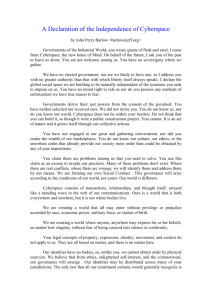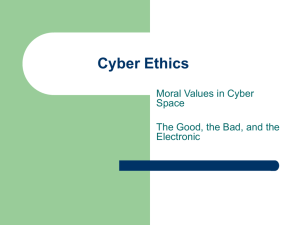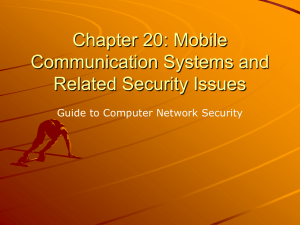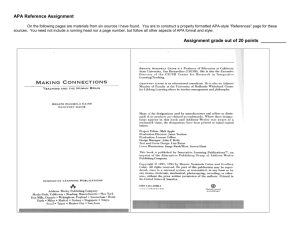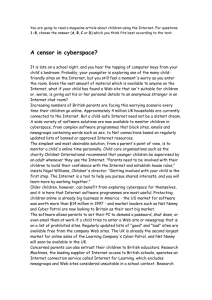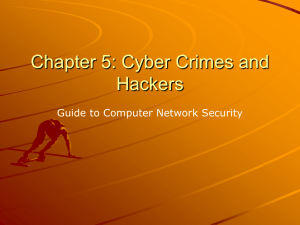Chapter 18: Other Efforts to Secure Information and Computer
advertisement
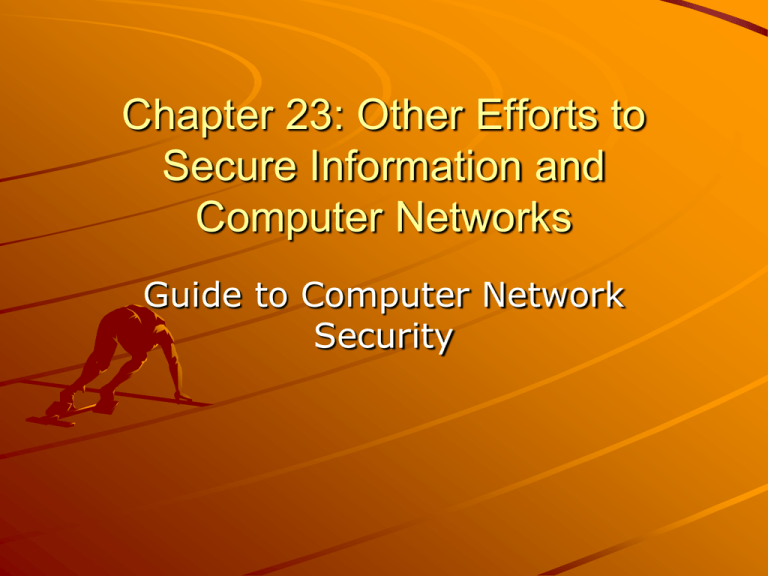
Chapter 23: Other Efforts to Secure Information and Computer Networks Guide to Computer Network Security The protection of information, on which we have come to depend so much, has been a major challenge since the birth of the Internet. The widespread adoption of computer technology for business, organization, and government operations, has made the problem of protecting critical personal, business, and national assets more urgent. When these assets are attacked, damaged or threatened, our own individual, business, and more importantly national security is at stake. The problem of protecting these assets is becoming a personal, business, and national priority that must involve everyone. Efforts and ways must be sought to this end. But getting this massive public involvement will require massive public efforts on several fronts including legislation, regulation, education, and activism. In this chapter, we examine these efforts. Kizza - Guide to Computer Network Security 2 Legislation As the Internet web grows, Internet activities increase, and e-commerce booms, and globalization spreads wider, citizens of every nation infuriated by what they see as the “bad” Internet are putting enormous and growing pressures on their national legislatures and other law making bodies to enact laws that would curb cyberspace activities in ways that they feel best serve their interests. The citizens’ cause has been joined by special interests groups representing a variety of causes such as environmental protection, free speech, intellectual property rights, privacy, censorship, and security. There is a need for legislation of Cyber space Yet it is not clear and probably unlikely that such actions will, at best stop and in the least arrest the escalating rate of illegal activities in cyberspace. Given the number of cyberspace legislations we presently have in place, and the seemingly escalating illegal cyberspace incidents, it looks like the patchwork of legislation will not in any meaningful way put a stop to these malicious activities in the near future 3 Kizza - Guide to Computer Network Security Regulation Conflicting forces from around the world are forcing governments to revisit, amend, and legislate new policies, charters, statutes, and acts. In many countries, large numbers of new regulations are being added to the books. Many out-dated laws and acts are being revisited, retooled and brought back in service. Kizza - Guide to Computer Network Security 4 Self-Regulation There are several reasons why self-regulation as a technique of cyberspace policing is appealing to a good cross-section of people around the globe. – One reason , supported mostly by the free-speech advocates, is to send a clear signal to governments around the world, that the cyberspace and its users are willing to self-regulate, rather than have the heavy hand of government decide what is or is not acceptable to them. – Secondly there is realization that although legislation and enforcement can go a long way in helping to curb cyber crimes, they are not going to perform the magic bullet that will eventually eradicate cyber crimes. This self-regulation cyberspace can be done through two approaches: hardware and software. Kizza - Guide to Computer Network Security 5 Hardware-Based Self-Regulation – There is a wide array of hardware tools to monitor and police cyberspace to a degree suited for each individual user of cyberspace. Among the tools are those individually set to control access, authorization, and authentication. Such hardware tools fall mainly in six areas namely: Prevention - Prevention is intended to restrict access to information on the system resources like disks on network hosts and network servers using technologies that permit only authorized people to the designated areas. Such technologies include, for example, firewalls. Protection - Protection is meant to routinely identify, evaluate, and update system security requirements to make them suitable, comprehensive, and effective. Detection - This involves deploying an early warning monitoring system for early discovery of security bleaches both planned and in progress. This category includes all Intrusion detection systems (IDS). Limitation - This is intended to cut the losses suffered in cases of failed security. Reaction - To analyze all possible security lapses and plan relevant remedial efforts for a better security system based on observed failures. Recovery - to recover what has been lost as quickly and efficiently as possible and update contingent recovery plans. Kizza - Guide to Computer Network Security 6 Software-Based Self-Regulation – Software solutions are many and varied in their approaches to cyberspace monitoring and control. They are also far less threatening and, therefore, more user friendly because they are closer to the user. This means that it can either be installed by the user on the user’s computer or by a network system administrator on a network server. Software controls fall into three categories: Rating programs: - Rating programs rate cyberspace content based on a selected set of criteria. Among such criteria are violence, language, and sex content. Software rating labels enable cyberspace content providers to place voluntary labels on their products according to a set of criteria.. Filtering Programs - Filtering software blocks documents and websites that contain materials designated on a filter Blocking – Blocking software works best only if all web materials are rated. But as we all know, with hundreds of thousands of websites submitted everyday, it is impossible to rate all materials on the Internet, at least at the moment. Kizza - Guide to Computer Network Security 7 Education Perhaps one of the most viable tools to prevent and curb illegal cyberspace activities is through mass education. Mass education involves teaching as many people as possible the values of security, responsible use of computer technology, how to handle security incidents, how to recover from security incidents, how to deal with the evidence if legal actions are to be followed, and how to report security incidents. Along these lines, therefore, education should be approached on two fronts: focused and mass education Kizza - Guide to Computer Network Security 8 Focused Education – Focused education targets groups of the population, for example children in schools, professionals, and certain religious and interests groups. – Focused education can be sub-divided into: formal education occasional education. Kizza - Guide to Computer Network Security 9 Mass Education – The purpose of mass education is to involve as many people as possible with limited resources and maximum effect. The methods to achieve this is usually through community involvement through community-based activities like charity walks and other sports related activities. Using an army of volunteers to organize local, regional, and national activities, the approach similar to common causes like AIDS, Cancer, and other life threatening diseases, can break quick and very effective awareness which leads to unprecedented education. Kizza - Guide to Computer Network Security 10 Reporting Centers – The purpose of these centers is to collect all relevant information on cyber attacks and make that information available to the general public. Market Forces – The rapid rise in cyber crimes has also prompted collaboration between private industry and government agencies to work together to warn the public of the dangers of cyber crimes and outline steps to take to remove the vulnerabilities thereby lessening chances of being attacked. Both major software and hardware manufacturers have been very active and prompt in posting, sending, and widely distributing advisories, vulnerability patches, and anti-virus software whenever their products are hit. Cisco, a major Internet infrastructure network device manufacturer, for example has been calling and emailing its customers, mainly Internet Service Providers (ISPs), worldwide notifying them of the possibilities of cyber attacks that target Cisco’s products. – It also informs its customers of software patches that could be used to resist or repair those attacks. It has also assisted in the dissemination of vital information to the general public through its web sites concerning those attacks and how to prevent and recover from them. Kizza - Guide to Computer Network Security 11 Activism – Widely used and less effective. – Advocacy It is a blanket mass education campaign in which a message is passed through mass campaigns, magazines, and electronic publications, support of public events and mass communication media like television, radio, and now the Internet. – Hotlines Hotlines is a technique that makes the general public take the initiative to observe, notice, and report incidents. Kizza - Guide to Computer Network Security 12

